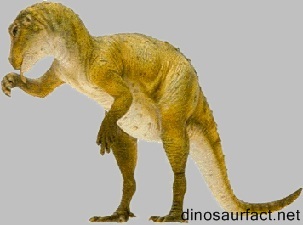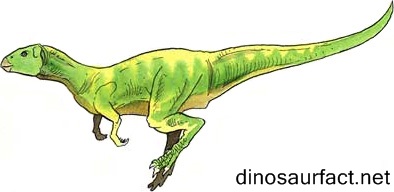 Click to visit the previous dinosaur bio
Click to visit the previous dinosaur bio
 |
|
 |
|
Kingdom: Animalia
Phylum: Chordata
Class: Sauropsida
Superorder: Dinosauria
Order: Ornithischia
Family: Fabrosauridae
Genus: Fabrosaurus
 |
|
 |
|
 |
|

The Fabrosaurus was a tiny dinosaur that was present in the early Jurassic period of the Mesozoic Era. It existed in Africa, as denoted by the location of its fossils. It roamed the earth about 200 to 189 million years ago.
The Fabrosaurus was an ornithischian dinosaur. It was herbivorous in its feeding habits, eating ferns and other vegetation. The size of the Fabrosaurus was similar to that of a toy breed dog.
The remains of the creature were discovered in South Africa in the Lesotho province. Very scant fossil evidence is available which is ascribed to the Fabrosaurus and hence no facts about it can be conclusively proven, except the dimensions of the skull.
Many paleontologists believe that the genus Fabrosaurus may identical to genus Lesothosaurus.
Nomenclature
The name ‘Fabrosaurus’ was suggested by paleontologist Leonard Ginsburg. He named it after his colleague, paleontologist Jean Henri Fabre.
The word ‘sauros’ translates to lizard in Greek. Thus, the word ‘Fabrosaurus’, when translated directly, denotes ‘lizard of Fabre’.
The specific name Fabrosaurus australis is derived from the place where the fossils were excavated in the Upper Elliot Formation.
Discovery and nature of fossils
- The fossils of the Fabrosaurus were excavated in the Upper Elliot Formation of southern Africa. They were discovered by scientists Leonard Ginsburg and Jean Fabre.
- They were discovered in Basutoland (currently Lesotho).
- The fossils comprised only of parts of the skull. These include fragments of the maxilla and mandible. A few teeth were also intact on the jaw bones.
- A few pieces of the cranium were also discovered. These included parts of the nasal, temporal, parietal, squamous bones etc. The orbits of the Fabrosaurus were successfully reconstructed using the skull fragments.
- The teeth were sharp and pointed and small.
These bones closely resemble those of the Lesothosaurus.
Taxonomic classification
The Fabrosaurus is classified under order ‘Ornithischia’. The dinosaurs belonging to order Ornithischia have pelvic girdles similar to that of birds.
Although no fossils of the hip joint are attributed to belong to the Fabrosaurus, comparisons have been made between the skull bones of the Lesothosaurus and the Fabrosaurus. As the skull of the Fabrosaurus closely resembles that of the Lesothosaurus, the Fabrosaurus is ascribed the same taxonomic classification as that of the Lesothosaurus.
Certain scientists believe that both the genera may represent the same organism. The slight variations in the skull bones of the two dinosaurs may have been due to differences in gender.
The Elliot Formation
The Elliot Formation is one of the most prominent geological structures of Africa. It is spread throughout the southern parts of the African continent.
In one part of this formation, The Upper Elliot Formation, the remains of the Fabrosaurus were excavated. This region is less diverse with respect to the rock strata as compared to the Lower Elliot Formation, but a larger number of dinosaur fossils were found in this region. The ornithischian dinosaurs, Lesothosaurus and Heterodontosaurus were also discovered here.
The Elliot Formation comprises chiefly of clay-stone, limestone and arenite.
Leonard Ginsburg and Jean Fabre
- Jean Henri Fabre:
Jean Fabre was a French paleontologist. He had published several scientific papers in collaboration with Leonard Ginsburg
- Leonard Ginsburg:
Leonard Ginsburg was a French scientist of Ukrainian origin. He was born in Paris in 1927. He had degrees in paleontology and geology.
Although he was an atheist, he was compelled to promote anti-Semitic propaganda during the Second World War.
Ginsburg has numerous publications under his name and has worked extensively in the field of vertebrate paleontology. His area of interest was Mesozoic era and the mammals and dinosaurs that inhabited the earth during that period.
He had worked at the Museum of Paris for over forty years, leaving it only at retirement.
Morphological features
- The Fabrosaurus was a very small dinosaur. The length of its body was only 1 meter from snout to tail. It was a thin dinosaur, weighing a modest 5 to 10 kilograms.
- Its skull was also small in size as compared to the rest of its body. Its jaws were angular like a beak.
- The teeth of the Fabrosaurus were pointed. They were adapted for tearing of leaves and plants. It most likely could not chew on its food properly and had to swallow it whole.
- It was an obligate biped with short fore arms.
- The hands of the Fabrosaurus had five digits. They were most likely adapted for grasping.
- It had a long tail, which it used to balance itself while running at high speeds.
The data mentioned above has been mostly extrapolated from the Lesothosaurus. Its accuracy cannot be considered canon.
Habits and habitat
Based upon the teeth fossils of the Fabrosaurus, it is considered a herbivore.
The habitat of the Fabrosaurus comprised of wooded areas interspersed with lakes and rivers.
Related and co-existing species
As mentioned earlier, the Fabrosaurus is considered to be very closely related to the Lesothosaurus.
Many scientists contend that the Fabrosaurus could possibly have been the ancestor of the Xiaosaurus. Although the Xiaosaurus was discovered in Asia, the connection is quite possible.
It is also considered possible that family Hypsilophodontidae could have evolved from dinosaurs such as the Fabrosaurus.
It is posited by some paleontologists that the Dilophosaurus and the Fabrosaurus could have coexisted. The Dilophosaurus most likely predated upon the Fabrosaurus.
Epilogue
Very little fossil evidence is available about the Fabrosaurus.
And the discovered fossils greatly resemble those of the Lesothosaurus. In fact most of the data about the Fabrosaurus is derived from the Lesothosaurus. Due to this, the genus Fabrosaurus is considered of uncertain origins. Many scientists believe that the fossils of the Fabrosaurus could be the same as the Lesothosaurus with only genders differing.
The exact taxonomic classification of the Fabrosaurus is still debatable. So is its lineage.
But that does not invalidate the fact that the discovery of the Fabrosaurus has been very important for the understanding of the early Jurassic dinosaurs. The herbivorous ornithischians of the middle Jurassic period could possibly have evolved from the Fabrosaurus.
There is much scope for the discovery of new fossils from the African continent. Only when such data becomes available can the information about the Fabrosaurus be augmented.
Index
Extinct Profiles
 Triassic Dinosaurs
Triassic Dinosaurs Jurassic Dinosaurs
Jurassic Dinosaurs Cretaceous Dinosaurs
Cretaceous Dinosaurs Pterosaurs
Pterosaurs Marine Reptiles
Marine Reptiles Dinosaur Extinction
Dinosaur Extinction